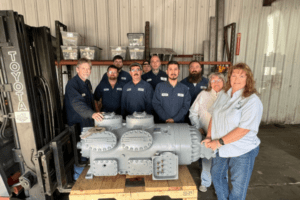Managing the temperature in a warehouse is no small task. With large open spaces, high ceilings, and varying climate conditions, warehouse cooling can become expensive if not carefully managed. HVAC/R technicians often seek solutions that balance performance with cost-efficiency, and one highly effective strategy is using industrial remanufactured HVAC compressors. These compressors provide a reliable, cost-effective, and environmentally friendly alternative to purchasing brand-new units.
This blog post explores how industrial remanufactured compressors can help reduce warehouse cooling costs and improve overall system efficiency.
What Are Remanufactured HVAC Compressors?
A remanufactured HVAC compressor is a previously used compressor that has been disassembled, cleaned, inspected, and remanufactured to meet or exceed original equipment manufacturer (OEM) standards. During the remanufacturing process, worn components are replaced, the unit is thoroughly tested for quality, and it is reassembled to operate like new. Unlike “rebuilt” compressors, which often involve replacing only the broken parts, remanufactured compressors undergo a rigorous process to ensure top performance and reliability.
Benefits of Remanufactured Compressors for Warehouses
1. Cost Savings
One of the most significant advantages of remanufactured compressors is the cost savings they offer. Warehouses often require multiple compressors to cool expansive areas, and replacing a failing compressor with a new one can be expensive with time delays. A remanufactured compressor typically costs a fraction of the price of a new unit while delivering comparable performance. For warehouse operators managing tight budgets, this can be a game-changer.
2. Sustainability
Environmental responsibility is becoming increasingly important for businesses across all industries. Using remanufactured compressors helps reduce waste by giving used equipment a second life. This approach minimizes the need for raw materials and energy consumption associated with manufacturing new industrial HVAC/R compressors. As a result, warehouses can contribute to a more sustainable future while maintaining efficient cooling systems.
3. Performance and Reliability
When sourced from a reputable supplier, like Compressors Unlimited, industrial HVAC/R remanufactured compressors are just as reliable as new ones. The remanufacturing process includes replacing worn or damaged components with new or reconditioned parts, ensuring that the compressor meets or exceeds OEM specifications. Rigorous testing is also conducted to guarantee the compressor can handle the demands of a warehouse industrial cooling system. For HVAC/R technicians, this reliability means fewer callbacks and long-term satisfaction for their clients.
Steps to Implement Remanufactured Industrial HVAC Compressors in a Warehouse
1. Assess the Current Industrial HVAC System
Before making any changes, evaluate the warehouse’s existing HVAC system. Identify compressors that are inefficient or nearing the end of their service life. If the system is struggling to maintain consistent temperatures or energy bills are skyrocketing, replacing older compressors with remanufactured ones would be an ideal solution.
2. Select a Trusted Supplier
Choosing a supplier is critical when investing in remanufactured industrial HVAC compressors. Look for suppliers who adhere to strict remanufacturing processes and offer a limited warranty on their products. A reliable supplier and a proper installation ensure you’re getting a high-quality product that will perform as expected and last for years.
3. Schedule Installation
Installing an industrial HVAC compressor requires careful planning to avoid disruptions to warehouse operations. Work with your team to schedule installation during off-peak hours or times when the warehouse is less active. Proper installation is essential for ensuring the system runs efficiently and that the compressor performs optimally.
4. Establish a Maintenance Routine
Routine maintenance is vital for keeping industrial HVAC systems running smoothly. Regularly inspect compressors for signs of wear, clean coils, and ensure proper refrigerant levels. A well-maintained system not only extends the lifespan of the compressors but also ensures consistent performance, helping to avoid unexpected breakdowns.
Additional Strategies to Reduce Cooling Costs
While integrating remanufactured compressors is a powerful step, combining this approach with other energy-saving practices can further enhance cost-efficiency. Here are a few additional tips for reducing cooling expenses:
Optimize Insulation
Proper insulation is one of the most effective ways to reduce cooling costs. Make sure the warehouse’s walls, ceilings, and doors are well-insulated to prevent cool air from escaping and warm air from entering. This reduces the workload on industrial-sized HVAC systems, leading to lower energy consumption.
Implement Zoning Systems
Warehouses often have different cooling needs for different areas. For instance, storage zones for temperature-sensitive products may require lower temperatures than general work areas. Dividing the warehouse into zones and controlling temperatures independently for each zone allows for more precise cooling, reducing overall energy use.
Use Energy-Efficient Equipment
Investing in energy-efficient equipment, such as LED lighting and high-efficiency fans, can help minimize the amount of heat generated inside the warehouse. Less heat means the cooling system doesn’t have to work as hard, leading to significant energy savings.
Leverage Preventive Maintenance
Preventive maintenance is essential for avoiding costly repairs and ensuring the industrial HVAC system operates efficiently. Regularly scheduled inspections, cleaning, and tuning of components, including compressors, keep the system in peak condition and extend its lifespan.
A Smarter Way to Save on Cooling Costs
For HVAC/R technicians and warehouse managers alike, managing cooling costs is a top priority. Incorporating remanufactured industrial HVAC compressors into the cooling system offers a practical and cost-effective solution. These compressors provide the same performance and reliability as new units while significantly reducing expenses and environmental impact.
By combining remanufactured industrial compressors with smart energy practices, such as proper insulation, zoning, and routine maintenance, warehouses can achieve efficient and affordable cooling. For businesses looking to stay competitive in a cost-conscious and eco-friendly world, this approach is a step in the right direction.












